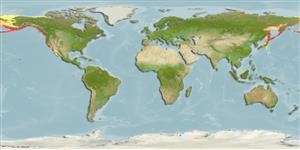>
Salmoniformes (Salmons) >
Salmonidae (Salmonids) > Salmoninae
Etymology: Oncorhynchus: Greek, onyx, -ychos = nail + Greek, rhyngchos = snout (Ref. 45335); kisutch: Most probably a typo in the emendada p720 for kisutch, which is the vernacular name of this fish in Kamtchatka (Ref. 1998).
More on author: Walbaum.
Environment: milieu / climate zone / depth range / distribution range
البيئة
بحري; المياه العذبة; مياه مخلوطة; أسماك صاعدة (Ref. 51243); نطاق العمق 0 - 250 m (Ref. 50550). Subtropical; 0°C - 25°C (Ref. 35682); 72°N - 22°N, 135°E - 111°W (Ref. 117423)
North Pacific: distributed from the Anadyr River in Russia south towards Hokkaido, Japan, and from Point Hope in Alaska southwards to Chamalu Bay in Baja California, Mexico.
الحجم / وزن / العمر
Maturity: Lm ? range ? - ? cm
Max length : 108 cm TL ذكر/ مختلط الجنس; (Ref. 40637); 65.5 cm (female); common length : 71.0 cm TL ذكر/ مختلط الجنس; (Ref. 593); common length :59.5 cm (female); أعلا وزن تم نشرة: 15.2 kg (Ref. 40637); العمر: 5 سنين (Ref. 36794)
الأشواك الظهرية (المجموع) : 0; الأشعة الظهرية الناعمة (المجموع) : 9 - 13; شوكة شرجية: 0; أشعه شرجية لينه: 12 - 17; فقرات: 61 - 69. Characterized by the presence of small black spots on the back and on the upper lobe of the caudal fin, and by the lack of dark pigment along the gum line of the lower jaw (Ref. 27547). The gill rakers are rough and widely spaced; the lateral line is nearly straight (Ref. 27547). The adipose fin is slender; the pelvic fins have an axillary extension (Ref. 27547). Fish in the sea are dark metallic blue or greenish on the back and upper sides, a brilliant silver color on middle and lower sides, and white below; small black spots are present on the back and upper sides and on the upper lobe of the caudal fin (Ref. 27547). During the spawning season fish turn dark to bright green on head and back, bright red on the sides, and often dark on the belly (Ref. 27547). Females are less brightly colored than males (Ref. 27547).
The fish occur in the ocean or in lakes; adults return to the rivers where they were born (Ref. 27547). The young fish emerge in springtime and they usually live in fresh water for 1-2 years (sometimes up to 4 years, Ref. 27547); later they migrate at night to freshwater lakes or to the sea (Ref. 1998). Epipelagic (Ref. 58426). The fish that stay more than two years in fresh water and become sexually ripe without ever going to sea, are called residuals; they never spawn (Ref. 27547). Young fish in lakes and rivers eat mainly insects; they stay almost entirely in deep parts of the river and soon become strongly territorial (Ref. 27547). Upon reaching the sea, the smolts remain close to the coast for a certain time, eating planktonic crustaceans (Ref. 27547). As they grow, they migrate farther out into the sea and hunt larger organisms (Ref. 27547) such as jellyfish, squids and fishes (Ref. 58426). They are hunted by various fishes, birds (mergansers, loons and kingfishers), mammals and lampreys (Ref. 1998). This kind is traded as fresh fish, dried or salted, smoked, canned, preserved and frozen (Ref. 9988). They are steamed, grilled, broiled, cooked in the microwave and baked (Ref. 9988).
Adults migrate from the sea or lake, school at mouths of rivers, and move upstream when rains increase river flow (Ref. 1998). As a rule, the winter entries (December and January) occur in the southern part of the range, with appearance in fresh water becoming progressively earlier to the north (Ref. 30381, 30382, 30383). At the spawning area, the female finds a spot and digs a pitt. At this point she is aggressive toward other females. While digging, an attendant male courts her or is busy driving away other males. As soon as the pitt is completed, the female drops into it and is immediately followed by the male. The pair are side by side, they open their mouth, quiver and release egg and sperm (Ref. 27547). At this point, other males move in and release sperm into the nest (Ref. 1998). The female quickly moves to the upstream edge of the nest and starts digging a new pitt, covering the eggs. The whole process is repeated for several days until the female deposits all her eggs. The male then leaves and may seek another female. The spent female usually continues to dig, until she dies (Ref. 27547).
Reproductive strategy: synchronous ovarian organization, determinate fecundity (Ref. 51846).
Page, L.M. and B.M. Burr, 2011. A field guide to freshwater fishes of North America north of Mexico. Boston : Houghton Mifflin Harcourt, 663p. (Ref. 86798)
IUCN Red List Status (Ref. 130435: Version 2024-1)
استخدامات بشرية
مصائد: ذو قيمة تاجرية عالية; الأستزراع المائي: تجاري; لعبة سمكه: نعم
أدوات
تقارير خاصة
Download XML
مصادر علي الأنترنت
Estimates based on models
Preferred temperature (Ref.
123201): 1 - 8.9, mean 3.9 °C (based on 453 cells).
Phylogenetic diversity index (Ref.
82804): PD
50 = 0.5000 [Uniqueness, from 0.5 = low to 2.0 = high].
Bayesian length-weight: a=0.01047 (0.00488 - 0.02245), b=3.04 (2.87 - 3.21), in cm total length, based on LWR estimates for this Genus-body shape (Ref.
93245).
مستوى غذائي (Ref.
69278): 4.2 ±0.70 se; based on food items.
المرونه (Ref.
120179): وسيط, الحد الزمني الأدني لتضاعف عدد أفراد المجتمع 1.4-4.4 سنة (K=0.98(?); tm=2-4; Fec=1,400).
Prior r = 0.32, 95% CL = 0.21 - 0.48, Based on 2 full stock assessments.
Fishing Vulnerability (Ref.
59153): Moderate to high vulnerability (50 of 100).
Climate Vulnerability (Ref.
125649): High to very high vulnerability (72 of 100).
Nutrients (Ref.
124155): Calcium = 31.9 [13.0, 81.4] mg/100g; Iron = 1.24 [0.62, 2.64] mg/100g; Protein = 19.8 [18.6, 20.9] %; Omega3 = 1.13 [0.55, 2.34] g/100g; Selenium = 161 [50, 502] μg/100g; VitaminA = 12 [3, 42] μg/100g; Zinc = 0.543 [0.347, 1.065] mg/100g (wet weight); based on
nutrient studies.
